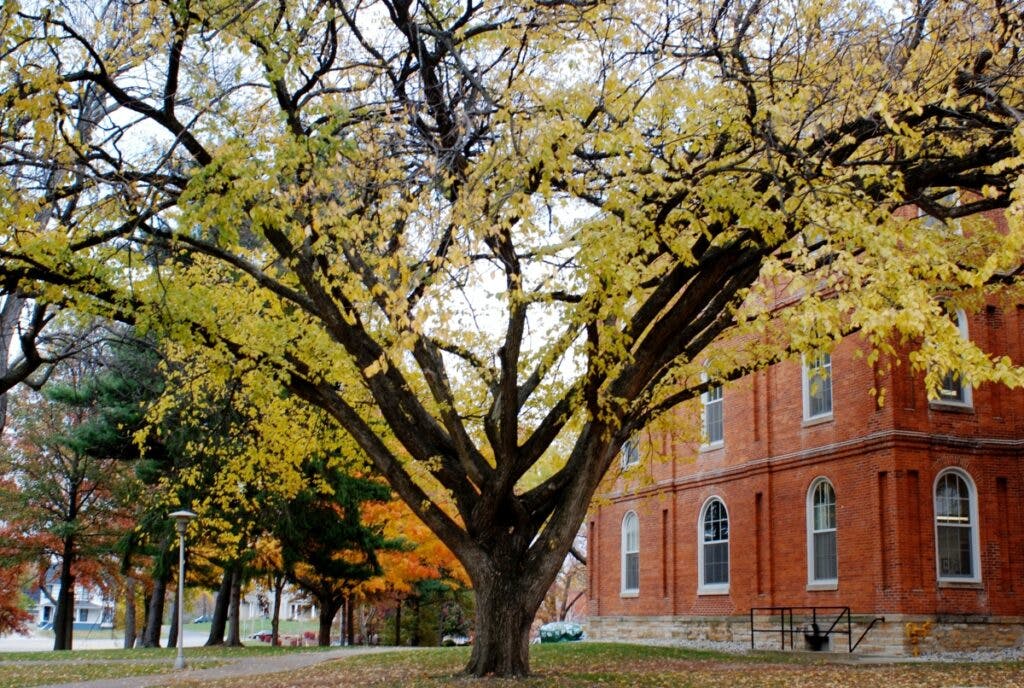Magnificent Logan Elm Holds Unique Place in U.S. and WC History
More than 200 species of trees and woody plants grace Wilmington College's contiguous campus, the 13.4-acre Frank O. Hazard Arboretum and the 19-acre S. Fredrik Anliot Natural Area along Lytle Creek, yet one stands out for both its beauty and history.
PICTURED: Wilmington College's Logan Elm stands just west of College Hall.
Just west of College Hall is a large American Elm whose trunk supports a twisting tangle of evenly distributed branches that produce a towering canopy offering summer shade and golden fall foliage — much like that of its prolific progenitor, the original Logan Elm.
For it was under that tree where, in October 1774, in Pickaway County, Ohio, on the historic banks of Scippo Creek just south of Circleville — then part of the Ohio Country — that representatives of England's Virginia Gov. Lord Dunmore and the Shawnee tribe met to determine peace terms following the Battle of Point Pleasant, which the English forces won. According to legend, there, the Shawnee ally and Seneca/Mingo-Cayuga tribe war leader, Logan (1723-1780), made his historic speech, known as "Logan's Lament."
Logan was distraught, as several months earlier, a rogue band of Virginia settlers, known as Long Knives, raided a Seneca-Cayuga settlement, Yellow Creek, in eastern Ohio and murdered a dozen residents, including members of Logan's family. This tragedy became known as the Yellow Creek Massacre.
Logan previously had fostered good relations with the white settlers. His brutal retaliation against Colonists in western Pennsylvania helped spark what became known as Dunmore's War, after which, under the great elm tree, there, "Logan the Orator," whose family had been slain, is believed to have painfully stated, "There runs not a drop of my blood in any living creature."
For many years, school children were required to memorize "Logan's Lament." It reads in part: "I appeal to any white to say, if he ever entered Logan's cabin hungry, and he gave him not meat; if ever he came cold and naked, and he clothed him not. Such was my love for the whites." Thomas Jefferson thought so highly of Logan's eloquent address he included it in his 1782 Notes on the State of Virginia.
The original Logan Elm was well over 250 years old and long revered as a natural monument before it finally succumbed and was leveled in 1964. The Ohio Historical Society had it cut into souvenir-size pieces. The massive tree had a 24-foot trunk circumference and stood 65 feet tall with a foliage spread of 180 feet. It was declared the oldest living thing on Ohio soil upon its demise.
But what of the origin of Wilmington College's Logan Elm?
In the 1920s through mid '40s, seeds and cuttings from the Logan Elm were propagated at a nursery at the Wooster Agriculture Experiment Station and planted in Scioto State Forest south of Chillicothe. More than 100 seedlings were lifted from the forest in 1935 and, through the cooperation of the Ohio Archaeological and Historical Society, Ohio Division of Forestry and the Ohio Federation of Women's Clubs (OFWC), each of the state's 88 counties was presented with a Logan Elm sapling.
The Wilmington Women's Club, in 1937, planted and dedicated a Logan Elm sapling in memory of Ellen C. Wright at the memorial service in the College Chapel following her death Jan. 8 at the age of 91. Wright, affectionately known as "Teacher Ellen," was a member of the College's first graduating class in 1875 and taught at the institution for 45 years from 1875 to 1920.
In 2007, Dr. S. Fredrik Anliot, professor emeritus of biology and longtime curator of Hazard Arboretum, said the tree is representative of what long was among the most desirable shade trees in the United States — until Dutch Elm Disease wiped out most of the nation's American Elms beginning in the 1920s.
"This elm (Ulmus americana) was our favorite boulevard tree and those of us who have observed elm-lined streets recall the green cathedral-like effect of the arching branches over the streets," Anliot wrote in his Notes of Wilmington College Campus Trees (1992).
"The elms are largely gone," Anliot added about the American variety, which is also known as the White Elm. He said Wilmington's Logan Elm has survived and flourished because it is an isolated tree that escaped the ravages brought about by the elm bark beetle and root grafts.
Adding credence to the argument the College possesses an actual Logan Elm is Logan's close connection with Quakers, which might have been a factor in the Women's Club presenting the tree. Indeed, the Pennsylvania-born Cayuga whose Native American name was Tocanioadorogon, was named for James Logan, secretary to English Quaker William Penn, the proprietor of Pennsylvania who purchased land from the indigenous tribes.
"Logan's father was an Iroquois chief and both were very impressed with Quakers," Anliot added.
WC alumnus Brad Schwamberger, a current curator of the College's Hazard Arboretum, is working on a video project in which he offers historic commentary on many of WC's distinct trees, including, of course, the Logan Elm.
"Part of the reason we have the Logan Elm cutting is to honor the largely peaceful relationship between Native Americans and Quakers."
